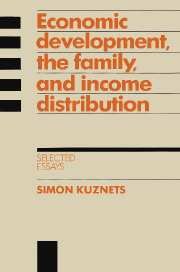Book contents
- Frontmatter
- Contents
- Preface by Louis Galambos and Robert Gallman
- Foreword by Richard A. Easterlin
- 1 Driving forces of economic growth: what can we learn from history?
- 2 A note on production structure and aggregate growth
- 3 The pattern of shift of labor force from agriculture, 1950–70
- 4 Modern economic growth and the less developed countries
- 5 Notes on demographic change
- 6 Recent population trends in less developed countries and implications for internal income inequality
- 7 Demographic aspects of the size distribution of income: an exploratory essay
- 8 Size and age structure of family households: exploratory comparisons
- 9 Size of households and income disparities
- 10 Distributions of households by size: differences and trends
- 11 Children and adults in the income distribution
- Afterword: Some notes on the scientific methods of Simon Kuznets by Robert William Fogel
- Bibliography of Simon Kuznets
- Index
8 - Size and age structure of family households: exploratory comparisons
Published online by Cambridge University Press: 12 November 2009
- Frontmatter
- Contents
- Preface by Louis Galambos and Robert Gallman
- Foreword by Richard A. Easterlin
- 1 Driving forces of economic growth: what can we learn from history?
- 2 A note on production structure and aggregate growth
- 3 The pattern of shift of labor force from agriculture, 1950–70
- 4 Modern economic growth and the less developed countries
- 5 Notes on demographic change
- 6 Recent population trends in less developed countries and implications for internal income inequality
- 7 Demographic aspects of the size distribution of income: an exploratory essay
- 8 Size and age structure of family households: exploratory comparisons
- 9 Size of households and income disparities
- 10 Distributions of households by size: differences and trends
- 11 Children and adults in the income distribution
- Afterword: Some notes on the scientific methods of Simon Kuznets by Robert William Fogel
- Bibliography of Simon Kuznets
- Index
Summary
A family may be defined as a group of persons “related, to a specified degree, through blood, adoption, or marriage”. The same source states: “The degree of relationship used in determining the limits of the family is dependent upon the uses to which the data are to be put and so cannot be precisely set for world-wide use”.
To the extent that ties of blood, marriage, or adoption are indicative of a community of interest of members, whatever their location, the family, in this broad sense, is an important unit in economic analysis – since it presumably makes joint decisions on the production and disposition of income, either in a continuous and comprehensive fashion, or intermittently and over a limited range. The possibility of such joint action makes the family unit useful in the study of income inequalities, of the supply of labor force, and of the flow of savings and capital formation.
The difficulty is that there are no comparative data on the family in the broad definition of the term. The available statistics relate to households, defined by location and by community of arrangements for providing essentials of living. The data usually cover all households, not limited to family households, although the latter are such a preponderant proportion that the characteristics of the totals can be identified as those of family households. The statistical analysis undertaken here is confined to data on households.
- Type
- Chapter
- Information
- Economic Development, the Family, and Income DistributionSelected Essays, pp. 240 - 277Publisher: Cambridge University PressPrint publication year: 1989



